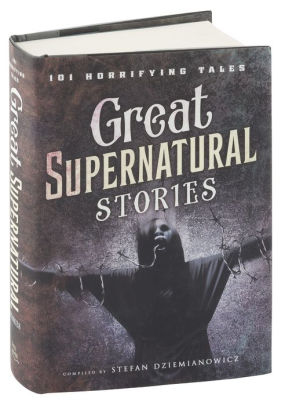Book Review: Great Supernatural Stories: 101 Horrifying Tales compiled by Stefan Dziemianowicz
This hefty volume collects a variety of public domain stories concerning the supernatural. While the majority fall roughly into the category of horror, some are more what we’d call “dark fantasy” and a handful are just “well, that’s a weird thing that happened.” The introduction mentions that many of these were published before genre fiction was so narrowly enforced, so any author could just plop down a supernatural story even if their usual output was say “kitchen sink” realism, without it being a big deal.

The stories are in alphabetical order by title, so the first tale in the volume is “Accessory Before the Fact” by Algernon Blackwood. A hiker takes a wrong turn somewhere, and experiences being murdered–but then he’s just fine. He later realizes he’s had a premonition that was meant for another man, but fails to do anything about it. Can he live with the guilt?
The final story is “White Zombie” by Vivian Meik. No relation to the Bela Lugosi film of the same title, this one is set in Africa. An English plantation owner’s widow is doing remarkably well after the death of her husband; everything seems to be running to perfection. And yet the commissioner senses something wrong in the atmosphere. Could it be…zombies?
This is easily the most use of racist tropes of a story in the collection, notwithstanding several “boy, India is creepy” tales. Much is made of the “Curse of Ham” by the local missionary. And that there’s a white zombie is supposed to be particularly horrific.
And yes, there’s a fair amount of period racism and sexism in these stories. Just saying, it’s not like that should be a surprise.
Since there are so many stories to pack in, all are fairly short, some down to two pages and no more than ten pages. That makes this volume an attractive option for readers who only have a few minutes at a time for a complete story. On the other hand, to not make this review too long, I’ll have to highlight only a few of the pieces.
“The Bold Dragoon, or, the Adventure of My Grandfather” by Washington Irving has the title character spending a night in an inn which only has one open bed–in a chamber reputed to be haunted. And certainly, the dancing furniture would seem to indicate something of the sort! This is one of several stories in the collection that emphasizes that the protagonist is the sort of down to earth person that one wouldn’t expect to see ghosts. The style of the story is verisimilitudinous, with the narrator stopping and restarting himself as he recollects details.
“The Damned Thing” by Ambrose Bierce starts with a coroner’s hearing, but the verdict is unsatisfying because the coroner decides not to enter certain evidence. We, the audience, do get to see that evidence. The section titles have a sardonic humor, and this is justly a famous story.
“‘Doubles’ and Quits” by Arthur Quiller-Couch is a funny tale of a stubborn couple who quarrel, and will not compromise, even after death.
“The Haunted Cap” by George W. Kelley is the tale of a Confederate soldier who kept a grotesque memento of the Union soldier he’d killed, a cap with a bullet hole in it. A cap that was haunted! At the end, the peculiar behavior of the cap has a “natural” explanation, but what about the rest of the events? I’d like to see this one made into a short film.
“Jikininki” by Lafcadio Hearn is a rendering of a Japanese ghost story about a monk who spends a night in a haunted village and learns of an eater of the dead. This one’s a bit creaky, but at least is told from the local lore, rather than from a tourist’s point of view.
“The Masque of the Red Death” by Edgar Allan Poe is a famous enough story that I can just say that it’s one of the best in the collection.
“The Mezzotint” by M.R. James is a creepy short about an engraving that changes when you aren’t looking at it, and explains an old tragedy. It also refers to an earlier M.R. James story, indicating that they happened at the same college.
“The Terrible Old Man” by H.P. Lovecraft has three robbers decide to terrorize an ancient and possibly senile retired sea captain for his reputed stash of gold coins. They are never seen again, or perhaps that should be stated as never recognized again. Lovecraft does a good job of understatement here.
And many more by such luminaries as E. Nesbit, Charles Dickens and H.G. Wells.
This volume is excellent value for money if you can put up with the usual period content issues.

